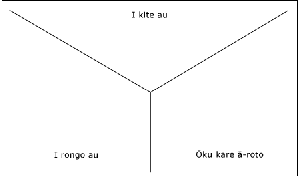Kupe – He tipuna hāereere
He whakarāpopoto
This article recounts the discovery of Aotearoa by Kupe in a chant like form. The first karanga is uttered by his first wife. He leaves behind his children Matiu and Makaro who become islands.
Ngā āhuatanga i roto i te tuhinga
He whatu tūkanga
- The article recounts some of the events that take place during Kupe's journey.
- Kupe's whānau are identified and the text records their contributions to the naming of landmarks.
- Kupe's wife, Kuramarotini, is known as Hine Te Aparangi in some regions.
He whatu tamariki
- The text encourages students to identify with Kupe who succeeded in overcoming major problems.
- The text provides students with a description of the journey of a famous explorer.
- The student will be able to identify place names and their meanings.
He whatu pānui
Hei tautoko i te kaipānui
- Written in a chant like form, the text recounts events as they unfold.
- The text follows the sequence of events from the time Kupe leaves Hawaiki until his return.
- The illustrations support the text.
Kia mataara!
- What impact did Kupe's journey have in your own area?
- What was happening in Hawaiki before Kupe left?
He kete reo
This story is a recount. Use the text to identify the characteristics of a recount.
Hei wānanga i te reo
Āpitihanga 1 – Ngā āheinga reo
| pōhiri/tono | karanga |
Āpitihanga 2 – Ngā ariā o te reo
| wāhi | |
| ngā pūanga: mai | hara mai, waiho mai |
| ngā hononga | |
| te kūmua pūtake: whaka | whakarite, whakamau |
Āpitihanga 4 – Ngā rārangi kupu
| Kōeke 1–3 | |
| a | Waiho mai a Matiu |
| hara mai | hara mai Kupe |
| huri | Huri noa i ... |
| iho | Hoki iho ... |
| reira | I reira ... |
| takutai | ki te takutai o ... |
| tohu | Hei tohu o ... |
| toroa | Toroa ngā ... |
| wehe | Ka wehe ko ... |
| waiho | Waiho mai a .. |
Hei wānanga i te reo
In this article there are instructional phrases with passive endings – toroa, whāia, terea. Compare with toro mai, whai mai, tere mai. When do you use passive endings?
Hei whakaihiihi
- Look at the title. What does 'hāereere' mean?
- How did Aotearoa get its name?
- Look at a map of Aotearoa. Focus on Te Whanganui a Tara, Raukawa Moana, and Totaranui. The place names commemorate the battle between an enormous octopus and Kupe. What happened in these places?
- Read each page in a similar fashion as a karanga.
Hei wānanga
- Divide the students into groups with one particular way to express the text on the page – chant, rhythm, karanga, or haka.
- Dramatise the text using mime.
- Make up some actions for each page.
- Explore terminology for 'distance'.
- Identify the characters and what they did.
- Identify the place names on a map.
- Te Wheke a Muturangi is the name of the octopus. Why is this octopus famous?
- Collect 10 facts about octopuses. Create a fact sheet.
- Why is the karanga important?
- Research Kupe's journey and the influence it had on the naming of these areas: Te Hokianga, Te Whanganui a Tara, and Totaranui.
Hei mahi kē atu
- Find out what the students know by using a MPA (KWL) chart. This stands for what I know – kei te mōhio au; what I want to know – kei te pīrangi au ki te mōhio; and what I have learnt – i ako au.
Kupe – He tipuna hāereere
| Kei te mōhio au | Kei te pirangi au ki te mōhio | I ako au |
- Use a cause-effect diagram. The children will read the text and draw pictures and/or write sentences to show the sequence of events during Kupe's journey. Accept and encourage individual variation.

- Draw a Y chart. Select a character from the text. Imagine you are that character and fill out the chart accordingly:

- Complete this recount – tuhinga taki
Kupe – He tipuna hāereere
Te whakatakotoranga:
- Āhea te mahi?
- Kei hea te mahi?
- Ki a wai?
- He aha ai?
Te haerenga:
- He aha te mahi i te tuatahi?
- Tētahi atu mahi?
- Te mutunga?
He whakapuaki māramatanga
- He roa te haerenga o Kupe mai i Hawaiki ki Aotearoa. He aha ngā wero i tūpono mai i a rātou?
- Ka whāia e rātou tētahi wheke. He aha ai?
- He aha te tohu whenua i kitea e Kuramarotini?



